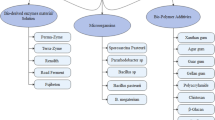Abstract
Dispersive soils are very abundant around the world; upon contact with water, the clay minerals in dispersive soils become strongly repulsed by each other and remain suspended apart from each other, a dangerous trend which has led to a number of irreparable damages. The soil used in this test was completely virgin and could be classified as a dispersive soil. In the first section of this study, the pinhole test was conducted on more than 20 selected additives; the results of these tests demonstrated that the best amending agents were calcium oxide and calcium hydroxide salts, in addition to polymer and cement compounds. A closer examination of the results obtained from the pinhole test for the six ideal additives, used at different percentages, revealed that even low percentages of lime, cement, and calcium hydroxide would dramatically reduce soil dispersivity. The combined effect of lime compounds with any of the (high pH) additives, including aluminum sulfate, pozzolan, and sulfur, at identical ratios represents their cumulative effect on the amendment intensity. The second section simultaneously explores the effects of several physical parameters of the amended soil including density, moisture, and time, through the test design method. The results obtained from this phase suggested that both increasing soil density and time would effectively amend the soil if used within their respective ranges, the former directly and the latter to a certain extent.





Similar content being viewed by others
References
Askari F, Fakher A (1991) Soil Dispersivity from the perspective of geotechnical engineering. Tehran University, Tehran (IR)
ASTM D4647-93 (2006) Standard test method for identification and classification of dispersive clay soils by the pinhole test. ASTM International, West Conshohocken. www.astm.org
Bazargan C, Ismaili SD (2010) Assessing and identifying the chemical indicator for the dispersivity potential of clay soils. J Eng Geol 4:917–942
Grant K, Ingles OG et al (1977) Protecting a dispersive soil storage by water treatment. ASTM STP 623:191–201
Ingles OG (1985) Piping in earth dams of dispersive clay. Am Soc Civil Eng 3:111–117
Jafari H, Hassanlou M (2012) Evaluating chemical stabilization of dispersive clay by aluminium sulfate (alum). World Appl Sci J 18:613–616
Mallela J, Quintus HV et al (2004) Consideration of lime-stabilized layer in mechanistic-empirical pavement design. The National Lime Association, Virginia
Moein B, Shoaee SM (2011) Evaluation criteria for dispersivity of clay soils. Applied Research Projects. Islamic Azad University, Zanjan
Mosavat N, Oh E, Chai G (2012) A review of electrokinetic treatment technique for improving the engineering characteristics of low permeable problematic soils. Int J Geomate 2:266–272
Nori P, Neishaburi M (2008) The effect of ESP and EC on selectivity factor gapoti in some soils affected by the salt plains in Tabriz [MA thesis]. Tabriz, Iran: Tabriz University
Ouhadi VR, Goodarzi AR (2006) Assessment of the stability of a dispersive soil treated by alum. Eng Geol 85:91–101
Rahimi F, Ghanbari A, Sadeqpour E (2008) The phenomenon of dispersivity in fine-grained soils and evaluating the results of different methods to identify soil dispersivity. Fourth National Congress of Civil Engineering, University of Tehran, Tehran
Ramezanpur A, Parhizkar T, Taheri A (1998) Application of pozzolan in concrete. J Build Hous Res 241:7–15
Richards LA (1954) Agriculture handbook no. 60. US Government Printing Office, Washington DC
Roy RK (2010) A primer on the Taguchi method, 2nd edn. Society of Manufacturing Engineers, Michigan
Ryker NL (1977) Encountering dispersive clays on soil conservation service project in Oklahoma; dispersion clays, related piping and erosion in geotechnical projects. ASTM STP 623(1):370–389
Sherard JL, Dunnigan LP, Decker RS (1976) Identification and nature of dispersive soils. J Geotech Eng 102:287–301
Spangler MS, Handy RL (1982) Soil engineering. HarperCollins, College Div, New York City (NY)
Umesha TS, Dinesh SV, Sivapullaiah PV (2009) Control of dispersivity of soil using lime and cement. Int J Geol 3:8–16
Vakili AH, Selamat MR, Moayedi H (2013) Effects of using pozzolan and portland cement in the treatment of dispersive clay. Sci World J 1:1–10
Author information
Authors and Affiliations
Corresponding author
Rights and permissions
About this article
Cite this article
Shoghi, H., Ghazavi, M. & Ganjian, N. The effects of chemical admixtures and physical factors on the treatment of dispersive soils. Arab J Geosci 10, 486 (2017). https://doi.org/10.1007/s12517-017-3263-y
Received:
Accepted:
Published:
DOI: https://doi.org/10.1007/s12517-017-3263-y




